U.S. Supreme Court Rules in Favor of Shoshone-Bannock Tribe
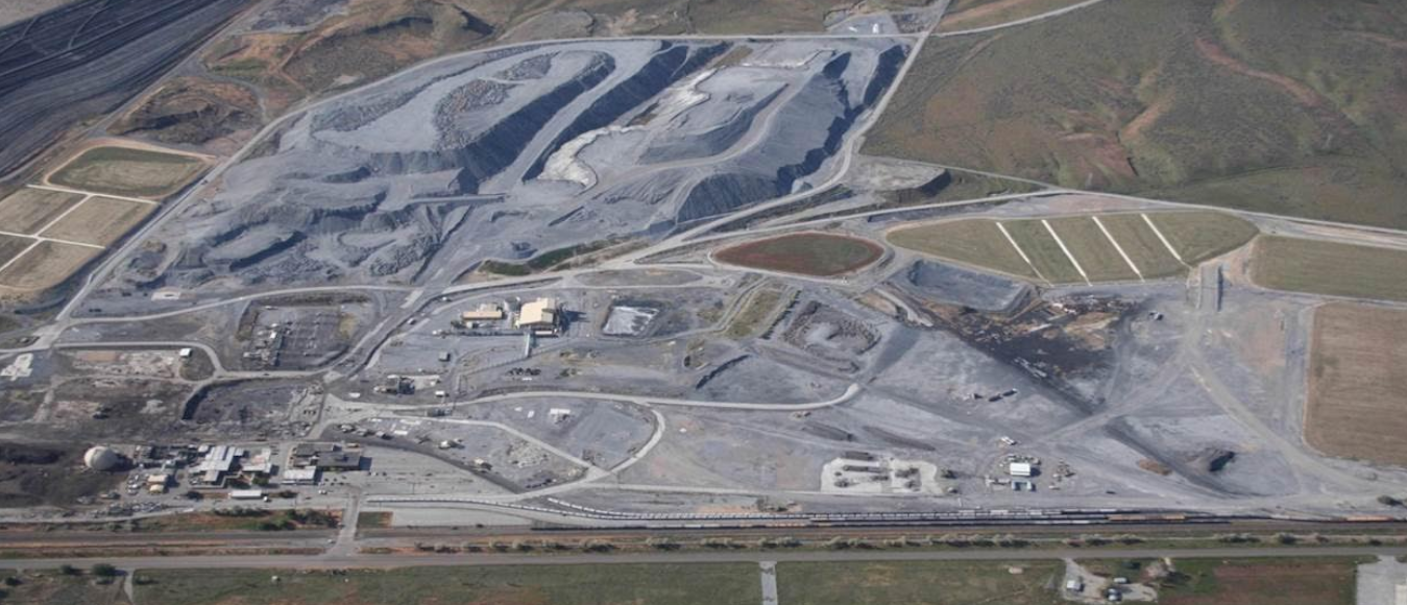
FORT HALL, Idaho — The United States Supreme Court on Monday rejected FMC Corporation’s final appeal to contest the jurisdiction of the Shoshone-Bannock Tribes to regulate storage of approximately 22 million tons of hazardous waste on the Fort Hall Reservation at the Eastern Michaud Superfund site west of Pocatello, Idaho.
“The Tribes are very pleased that the Supreme Court of the United States did not find any merit to FMC’s appeal and that FMC is finally required to honor their agreement to comply with Tribal jurisdiction,” Chairman Devon Boyer, of the Fort Hall Business Council said.
By denying certiorari, the U.S. Supreme Court defers to the findings of the Shoshone-Bannock Tribal Courts and the Ninth Circuit Court of Appeals affirmation of the District Court’s findings requiring FMC to comply with tribal jurisdiction.
In 1998, FMC voluntarily agreed to conditions of a tribal annual permit but after four years, when FMC closed business operations in 2002, they refused to honor their agreement and left their hazardous waste within the reservation. During this time the tribes created the Shoshone-Bannock Tribes’ Waste Management Act, which spelled out requirements for companies who generate or store waste on the reservation, including monitoring of sources of contamination.
The ruling is significant to Indian Country because it confirms corporations must comply with tribal regulations when doing business on tribal lands.
“This decision helps all of Indian Country in efforts to protect Tribal lands and natural resources as well as the betterment of all people of southeast Idaho. When industry enters into a voluntary relationship within tribal lands, they must comply with tribal regulations even when the EPA and/or states may have their own regulatory presence,” Chairman Boyer added.
The ruling is also a positive in tribal efforts to protect the environment.
“This decision furthers the Tribes’ efforts to protect the water and natural resources of the Reservation and surrounding communities. This is a victory for Mother Earth and the Tribes’ ability to protect our water and environment,” Councilman Lee Juan Tyler stated.
In 2005, the Shoshone-Bannock Tribes filed suit in the U.S. Idaho Federal District Court to force FMC to comply with its agreement to obtain the annual tribal permit. Since then, both tribal and federal courts have consistently ruled that FMC is required to comply with the voluntary agreement they entered into with the tribes. FMC has appealed every court ruling. Now, almost twenty years later, no more appeals are available to FMC.
Council member Nathan Small acknowledged the diligent work on this case by tribal leaders and staff. “We are grateful for the leadership and teamwork completed by our prior Tribal Council members, our Land Use Policy Commissioners, Environmental Waste Management Program staff, contractors, and attorneys since 1998,” Small said.
Returning the Land
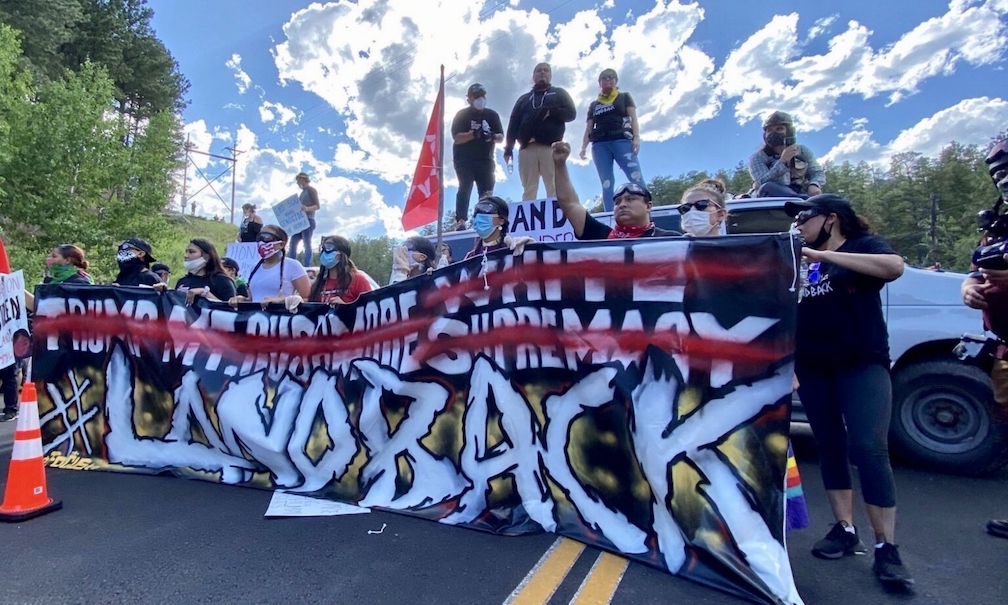
Indigenous leaders on the growing ‘landback’ movement and their fight for climate justice.
For many first peoples, Mount Rushmore stands as a monument to oppression. Carved into stolen land as a shrine to American exceptionalism by a sculptor who sympathized with the Ku Klux Klan, the site has become a symbol of Indigenous resistance and a backdrop for protest.
Just before Independence Day, scores of land defenders gathered at the national memorial in the Black Hills of South Dakota as President Trump took the stage for a rally. They came to denounce not just his invective and policies, but the white supremacy, oppression, and violence the immense granite sculpture represents. One demand underscored the protest: Indigenous people want their land back.
The demonstration, which saw the arrest of 20 people, catalyzed a campaign to reclaim the Black Hills and close Mount Rushmore. But the idea of “landback” — returning land to the stewardship of Indigenous peoples — has existed in different forms since colonial governments seized it in the first place. “Any time an Indigenous person or nation has pushed back against the oppressive state, they are exercising some form of landback,” says Nickita Longman, a community organizer from George Gordon First Nation in Saskatchewan, Canada.
The movement goes beyond the transfer of deeds to include respecting Indigenous rights, preserving languages and traditions, and ensuring food sovereignty, housing, and clean air and water. Above all, it is a rallying cry for dismantling white supremacy and the harms of capitalism. Although these goals are herculean, the landback movement has seen recent successes, including the removal of dams along the Klamath River in Oregon following a long campaign by the Yurok Tribe and other activists, and the return of 1,200 acres in Big Sur, California, to the formerly landless Esselen Tribe.
Such victories can help mitigate the impacts of climate change. In 2019, the Intergovernmental Panel on Climate Change recognized that Indigenous rights and climate action are inherently intertwined. From fire management to forest stewardship, Indigenous peoples have over generations amassed crucial knowledge about living and caring for ecosystems in a sustainable manner. It’s no wonder many consider landback a keystone of environmental justice.
“As organizers, oftentimes we do this work knowing that we may not be alive to eat the fruits of our labor,” says Krystal Two Bulls, director of the nascent landback campaign at NDN Collective. “But landback is one of those things that I know is possible. I will be alive to see Mount Rushmore closed and to see public lands in the Black Hills returned.”
Fix spoke to four Indigenous organizers and community leaders about what landback means to them, how it’s being implemented (including on traditional Maskoke land in Alabama), and how they see the movement entering the mainstream — and helping save our shared planet. Their responses have been edited for length and clarity.
The past, present, and future of the landback movement
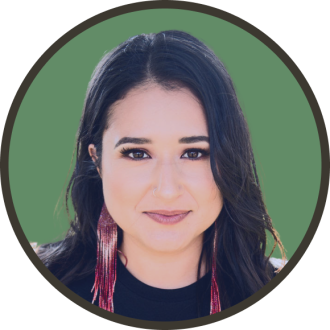
Nickita Longman is a Saulteaux* woman from George Gordon First Nation in Saskatchewan, Canada. Longman is a writer and community organizer, and she served as a guest editor for the LandBack issue of Briarpatch magazine in September.
Our histories teach us that there have been generations before us driven by their own versions of landback. The online uprising of #LandBack has been so wildly popular because it’s a term that is accessible to everyone and it signals something much larger than the language often used in academia, like “decolonization” and “Indigenization.” Landback cannot be co-opted by the government and turned into a performance, either, perhaps in the way we have seen with “reconciliation.” Landback is a statement. It’s a demand. There is no room for discussion or theory, and it will not wait on recommendations or policy change.
Landback, to me, means a combination of a return to things while also taking into account the ways in which Indigenous people have evolved into the present and how we will continue to evolve into the future. Landback means access to sustainable food from the land, and it means affordable housing in urban settings. It means a return to our languages and incorporating harm-reduction strategies into ceremony. It means a return to matriarchy in a way that my generation has never known. Landback, to me, is this beautiful fusion of the core foundations of our ancestors, with room for growth and expansion in envisioning Indigenous futurisms. In 10 or 20 years, I hope Indigenous people are speaking our languages, practicing food sovereignty, and exercising full jurisdiction over land and water both in rural and urban spaces.
Non-Indigenous climate organizers should be looking to the landback movement as a source of inspiration and guidance. As Idle No More [a grassroots advocacy group for Indigenous empowerment] has stated, “Indigenous sovereignty is climate action.” It is in the best interest of the mainstream climate movement to center Indigenous land, water, and sky protectors in their organizing. To avoid doing so is to carry on the legacy of colonization and white supremacy.
Landback in action
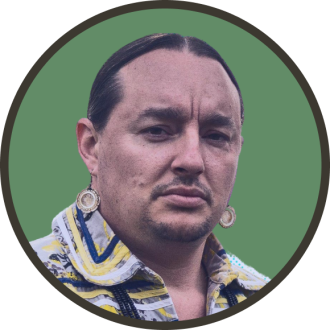
Marcus Briggs-Cloud is a Grist 50 Fixer and co-director of Ekvn-Yefolecv Maskoke ecovillage. (Ekvn-Yefolecv means “returning to the earth” In Maskoke.) The village covers 1,175 acres in Alabama, where Briggs-Cloud, 16 of his Maskoke relatives, and others are building a sustainable community, preserving their language and traditions, and living in a symbiotic relationship with the land.
The impetus behind the ecovillage is language revitalization. I wanted to see my language survive — but we can’t just say that we want a language-immersion program. We can’t just say that we want a food sovereignty program or regenerative agriculture, or natural building. We have to do all those things, hollistically.
The ecovillage is located an hour and a half south of Birmingham. This is traditional Maskoke homelands — almost 54 million acres were illegally ceded to the United States between 1790 and 1832 to become Alabama and Georgia. When we were thinking about where to place this ecovillage, it became spiritually evident that we needed to return to our traditional homelands. Not only to engage in physical stewardship of the land, but a spiritual renewal as well, because we have this inherent ethical responsibility to care for the ecosystems in this bioregion, where we resided since time immemorial. That teaching goes back to our origin and migration stories.
The ways that our Indigenous ancestors defined relationships to land are sparsely known today because of the impacts of colonialism. If we really want to know our relationship to land and the most authentic worldview that the ancestors left to us, we have to look to the language.
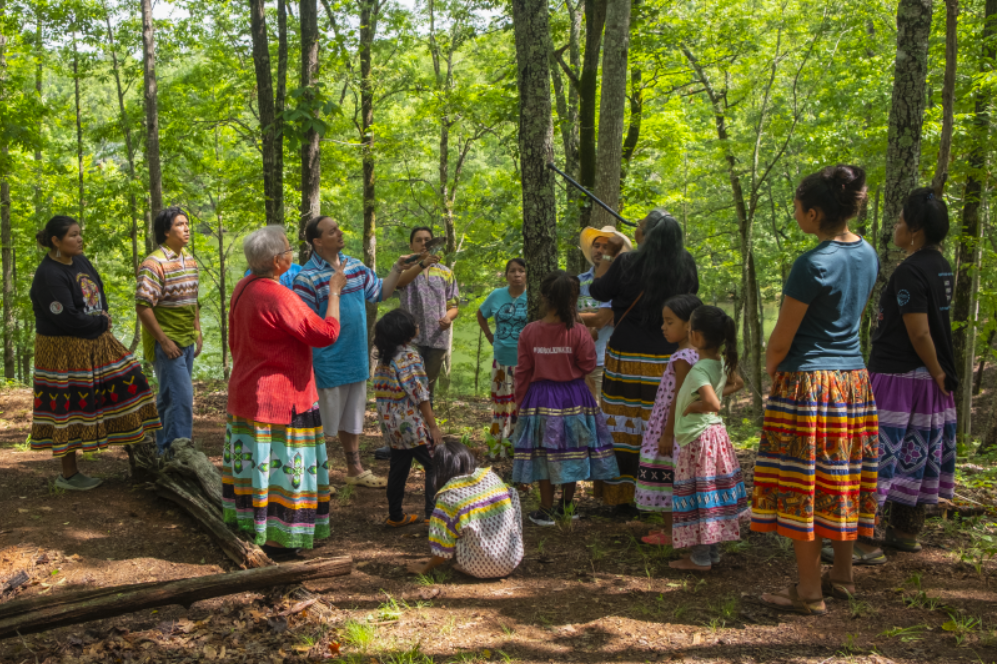
The grammar of our Maskoke language literally constrains our ability to articulate ownership of and extractive economic relationships to land. We have to code switch to English to speak of those ways. So if we didn’t own it in the first place, it’s hard to talk about getting land back. I think it’s better to put it in terms of returning land to the traditional stewards to fulfill their inherent covenants to be caretakers of a particular place, per their own canon of stories. When people do land acknowledgements, for instance, what we’re acknowledging is not that somebody owned land. We’re acknowledging that countless generations of ancestors before us conducted renewal ceremonies to stay in right relationship with that land.
At Ekvn-Yefolecv, we have a ceremony with every single tree before we fell it. Then we skid, debark, and mill the timber onsite, to avoid fossil fuel consumption and carbon emissions that would have been required to import timber. We are reintroducing buffalo and lake sturgeon. This fish is sacred to our people, but they were extirpated from our traditional Maskoke homelands because of the hydroelectric dams that were erected on the Coosa River. It was about 70 years ago that the last lake sturgeon were seen as naturally occurring in the Coosa watershed. This past spring, on Earth Day, we put the first group of sturgeon back into the river.
Landback affords us the opportunity to decolonize our relationship to land. And if we’re not going to be serious about that, then I don’t think that we should be engaged in seeking the return of our ancestral homelands. By decolonizing, I mean that we have to reject the commodification and exploitation of land. We have to reject the extractive economy and be willing to live simply. If we’re not living as minimalists, I think we’re fooling ourselves that we’re in right relationship with the Earth and all living beings She hosts. If it’s not the land we’re living on that’s being abused and exploited for capital, it’s some other Indigenous peoples’ traditional homelands that are being abused.
Building a campaign to sustain the movement
Nick Tilsen (a Grist 50 Fixer) is the president and CEO of NDN Collective and a citizen of the Oglala Lakota Nation. Krystal Two Bulls is the director of the landback campaign with NDN Collective and is Oglala Lakota and Northern Cheyenne from Lame Deer, Montana. They lead a team of organizers working to advance the landback movement.
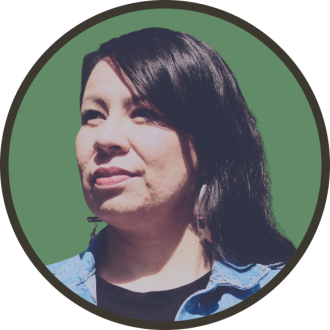
Two Bulls: The narrative that we’re putting forward is simply demanding Indigenous lands be returned to Indigenous hands. We acknowledge that this landback narrative existed long before us coming out with our campaign — this is generations and generations of work and effort and sacrifice from Indigenous peoples all over Turtle Island and even the world. What we’re doing with NDN Collective is stepping into this long legacy.
We have noticed that the fights and the movements that fall underneath landback were not coordinated and connected. Through our newly launched campaign, we are operating as the mechanism that coordinates, connects, amplifies, resources, and politicizes Indian country and all of the frontline fights that are happening.
There are a few central demands of our campaign: First is to dismantle white supremacy, period, and the systems and institutions that uphold it. Second is to defund all of the mechanisms that enforce white supremacy — the military-industrial complex, the police, ICE, border patrol. And then return. Starting with public lands, return them to the original stewards. Lastly, consent. This speaks to a shift in mindset, where we are no longer asking permission for these things. If you don’t get consent based on your decisions that are going to impact our lives and our connection to the land, then we have the right to say “no.”
The cornerstone of what we are pushing, the starting point, is our local campaign in the Black Hills. We are demanding the closure of Mount Rushmore, and that all public lands in the Black Hills be returned to the original stewards — and we’re developing a consortium of tribes that the land will be returned to.
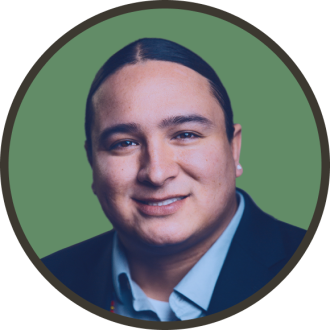
Tilsen: We believe that the Black Hills issue is catalytic to the overall landback movement. This is home to the longest legal battle between Indigenous people and the U.S. court system. The stealing of the Black Hills went all the way to the Supreme Court — which ruled that, in fact, it was a gross violation of the U.S. constitution. Yet, they didn’t return lands to our people. Last I checked, about 68 tribes have a stake in the Black Hills. Tribes use it for spiritual purposes, and have for thousands of years. When we did our action there on July 3, standing against the president of the United States in the sacred Black Hills to illuminate these issues, we used the landback narrative as part of that. It has proven to be catalytic. Quite frankly, as much as it was an action, it was also a ceremony. It was a commitment that we made to keep this work going.

What we’re calling for now is an entirely new policy era based on free and prior informed consent. If you look at how the United States and other colonial governments dealt with Indigenous people, we were originally dealt with in the department of war. And then we moved over into some kind of quasi-tribal government structure that was created by the oppressors. And then they decided that was too expensive. So then came the termination era, in which the federal government terminated assistance and the legal status of more than 100 tribes. And then, because of the rising of the 1960s and ’70s, came the self-determination era; tribal consultation became a bedrock of that policy era. It’s important to understand that arc when we talk about moving into this new era of consent. It’s also important to note that this is consistent with the United Nations Declaration on the Rights of Indigenous Peoples.
What we’re saying is, don’t create places for us in your white-supremacist structures. We actually want to create our own systems founded in Indigenous values. For us, if you’re going to have racial justice and racial equity for Indigenous people in this country, it has to include landback. It’s not a choice. It’s a demand.
Brazil to prioritize elderly, indigenous and health workers for COVID-19 vaccine

BRASILIA (Reuters) – Indigenous people, health workers and those aged 75 years and older will be at the front of the line to be vaccinated against COVID-19, Brazil’s Health Ministry said on Tuesday as it unveiled a four-stage preliminary plan for national immunization.
People aged 60 to 74 will be vaccinated in the second stage, and those with prior health conditions such as heart or kidney disease would be covered in a third stage.
The final stage, before making a vaccine available to the wider population, would include teachers, security personnel and first responders, along with prison staff and inmates, the Health Ministry said. The four stages would cover 109.5 million people out Brazil’s total population of 212 million.
The ministry said in a statement that the plan would be finalized once it was clear what vaccines were available.
A senior Health Ministry official said on Tuesday that the ideal candidate for Brazil would be a less costly one-dose vaccine that can be transported and stored at temperatures between 2 degrees and 8 degrees Celsius (36-46 degrees Fahrenheit).
Among the vaccines Brazil is considering for eventual purchase, the only single-dose vaccine is under development by Johnson & Johnson’s Belgian pharmaceutical subsidiary Janssen. The European Medicines Agency on Tuesday said it had started a real-time review of J&J’s vaccine candidate after preliminary results showed that the shot triggered the production of antibodies and immune cells against the virus.
The ministry said it has so far guaranteed access to 142.9 million doses of vaccines against COVID-19, of which 100.4 million doses are under an agreement with AstraZeneca PLC, and another 14.5 million through the Covax Facility co-led by the World Health Organization (WHO), Gavi – the Vaccine Alliance and the Coalition for Epidemic Preparedness Innovations (CEPI).
The ministry said it was in the process of buying 300 million syringes and needles in Brazil and another 40 million abroad.
Brazil has registered nearly 6.4 million cases of the novel coronavirus since the pandemic began, while the official death toll has risen past 173,000 — the world’s third-biggest outbreak after the United States and India.
The Health Ministry on Tuesday reported 50,909 additional confirmed cases of the novel coronavirus in the past 24 hours, the highest daily case number since early September, along with 697 new COVID-19 deaths.
The country’s state governors and opposition politicians have been pressing the government of far-right President Jair Bolsonaro to draw up a national immunization plan.
Why protecting Indigenous communities can also help save the Earth

For thousands of years, Indigenous communities have been caretakers of the environment, protecting their lands, respecting wildlife and utilizing traditional knowledge passed down through generations.
Today, they continue to safeguard some of the most biodiverse areas on the planet. Almost 50% of the world’s land mass (minus Antarctica) is occupied, owned or managed by Indigenous peoples and local communities, with roughly 40% of those landscapes labeled as protected or ecologically sound. And though Indigenous peoples comprise only around 6% of the global population, they protect 80% of biodiversity left in the world. Preserving biodiversity is also key to turning around the climate crisis, as these areas are major carbon sinks.
At the same time, many Indigenous communities – especially those in isolated regions – continue to face threats like disease outbreaks, poverty, environmental injustices and human rights violations. Some rural populations may even be facing extinction: one 2016 study followed eight Indigenous groups living in isolated areas in South America over the course of a decade, and found only one group to be growing, while the rest were small and sparsely populated.
“As go our peoples, so goes the planet,” says Nemonte Nenquimo, a leader in the Waorani community in Ecuador and founding member of Indigenous-led nonprofit organization the Ceibo Alliance. “The climate depends on the survival of our cultures and our territories.”
PROTECTORS OF THE PLANET
Growing up in the rainforests of Ecuador, Nenquimo deeply respects the flora- and fauna-rich land. Waorani territory spans 2.5m acres and is home to 800 species of animals and birds, many of which are endangered. The forest also acts like a natural pharmacy, producing plants with medicinal properties that can treat everything from wounds to snake bites. One Waorani discovery called curare, a plant extract traditionally used to make poison darts, was developed into a muscle relaxant now popularly used in anesthesia.
Beyond being one of the most biodiverse regions on Earth, the Amazon rainforest generates more than 20% of the world’s oxygen. Tropical forests also help slow climate change by acting as giant carbon sinks that absorb and store excess CO2 from the atmosphere. Right now, trees in these forests store roughly 250 billion tons of carbon, although capacity is decreasing as rainforests are continuously depleted, notes a March 2020 study.

- (Center) A Waorani elder stands alongside a gas flare near an oil refinery some 32 kilometers (20 miles) from the Amazonian city of Lago Agrio, Ecuador. Photo Mitch Anderson / Amazon Frontlines
Yet, for many years, the Waorani people have had to fight against destructive activities like oil drilling, deforestation and industrial-scale agriculture.
“Our brothers and sisters living in isolation have made the decision to live in the way of their ancestors, but the world is closing in on them,” says Nenquimo. And now, the coronavirus pandemic is threatening the livelihood of Indigenous communities like her own. “The global economy continues to drive poachers, loggers and land grabbers deep into our territories, putting our peoples at risk.”
Advocates like Nenquimo continue fighting to conserve their land. Teaming up with nonprofit organization Amazon Frontlines, the Ceibo Alliance is already paving the way for change after winning a historic legal battle in which the Ecuadorian government passed a ruling protecting 500,000 acres of the Amazon rainforest. Plus, they also set a legal precedent to protect an additional 7m acres from being auctioned off to oil companies.
While Indigenous communities continue to step up for the planet, they can’t do it alone. “We are all in this together. We need the world to recognize this,” says Nenquimo. “This isn’t about Indigenous peoples fighting heroically and risking our lives to protect the land. This is about us all joining together across cultures, races and classes to change the way our global system works.”
One such organization taking action is One Earth, a philanthropic initiative that aims to mobilize capital to solve the climate crisis and keep the global average temperature below 1.5°C. Co-founder and executive director Justin Winters says with every tenth of a degree the temperature rises, the closer the globe is to spinning out of control and launching into what scientists have dubbed the sixth mass extinction.
A key tenet of One Earth’s strategy to curb warming is to restore and protect 50% of all land and seas. “Many people today lack an understanding of our reliance on Earth, its vast biodiversity and ingenious, brilliantly designed systems that have evolved over millions of years to support life,” says Winters.
We have a lot to learn from those who do understand the symbiotic relationship between humans and the earth, Winters says, and we can’t protect the planet without the traditional knowledge and sustainable agriculture practices of Indigenous peoples living in these areas.
“There are leaders like Nemonte all over the world who are fighting hard to protect their lands, their waters, their families, their future – their home,” Winters says. “We have underestimated the power and importance of frontline communities and nature for far too long.”
“The Earth is our teacher, and we are listening to her,” says Nenquimo. “Because Indigenous peoples are so close to the land, we also have a lot to teach the rest of the world about respect for the Earth, and about spirituality and reciprocity.”
HOW A GLOBAL SAFETY NET CAN ENSURE A BETTER FUTURE
As a growing swell of scientific research highlights the integral role Indigenous communities play in environmental conservation, new technologies are emerging that will help to protect them and the regions they care for. One such innovation is the Global Safety Net, a “blueprint” to restore our biosphere, rebalance the global climate system and help prevent future pandemics. The two-year research effort mapped all lands of importance for biodiversity and ecosystem services, and determined how these lands can be woven back together through a network of corridors, restoring 350 mega-hectares of degraded land.
“The Global Safety Net is the first ever spatially-explicit framework that highlights sites of particular importance for both biodiversity conservation and carbon storage,” says wildlife scientist Eric Dinerstein, director of Biodiversity and Wildlife Solutions at RESOLVE. “It’s a dynamic tool designed to support multilateral, national and subnational land use planning efforts to save life on Earth.” With the overall goal to overcome climate change and restore the natural world, the Global Safety Net aims to prevent a sixth mass extinction event by making our ecosystems more resilient as the planet warms.
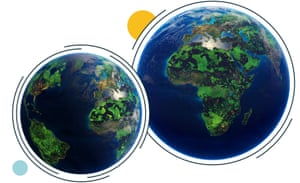
- Using global biodiversity and carbon spatial data, the Global Safety Net identifies terrestrial areas where expanding protection to approximately half the Earth can reverse biodiversity loss and stabilize the climate. Shown here is a visualization of Africa and Europe.
The Global Safety Net also recognizes that supporting Indigenous communities is critical to achieving these benchmarks. “We found that addressing Indigenous land claims, upholding existing land tenure rights and resourcing programs on Indigenous-managed lands could help achieve biodiversity objectives on as much as one-third of the area required by the Global Safety Net,” says Dinerstein.
Based on Dinerstein’s research, he says an additional 35% of land areas need to be protected in order to preserve the environment and stall climate change. “Stabilizing the climate and reversing biodiversity loss are interdependent; we cannot achieve one goal without accomplishing the other,” he says. “This must be done within the next decade. The level of planning and foresight needed to properly scale nature conservation requires the emergence of a worldview that embraces the notion of stewardship at a planetary scale.”
IT’S NOT TOO LATE. HERE’S HOW YOU CAN HELP
Reversing climate change is a massively complex and overwhelming task. And with the deluge of depressing headlines dominating the news cycle, it’s easy to feel hopeless about the future. “Some people question whether it’s still possible to solve the climate crisis,” Winters says. “One of the central and often overlooked solutions to climate change is protecting nature.”
Already people are taking action, and we’re seeing results. Countries are shutting down coal-fired plants. Many governments have committed to zero carbon emissions. Wind and solar power are quickly becoming some of the least expensive forms of electricity in the world.
At the same time, Indigenous peoples’ contributions to conservation are being increasingly recognized. The United Nations Declaration on the Rights of Indigenous Peoples was adopted in 2007, and remains one of the most comprehensive international declarations protecting Indigenous rights today. In 2016, the American Declaration on the Rights of Indigenous Peoples was adopted. Two years later, the Green Climate Fund adopted the Indigenous Peoples Policy, which recognizes and assists fully engaging Indigenous communities in decision-making related to their land and reducing global warming. And of course, Nenquimo and her fellow advocates’ recent victory securing the protection of 500,000 acres of rainforest is a huge step forward.
When it comes to making an impact yourself, there are many ways to get involved. On a local level, Dinerstein invites people to explore the Global Safety Net app, created in partnership with Google, and find important ecosystems in their local region to support. Replacing lawns with small native wildflower meadows or miniature forests are great ways to help nature, with advocates finding such forests to store up to 40 times more carbon and increase biodiversity by 100 times.
People can also practice conscious consumerism and reduce their carbon footprint by walking, biking and using public transportation, as well as cutting back on meat consumption and only buying products that are sourced sustainably. Get active on the political scene: help change legislation by signing petitions, switching banks and voting for leaders who recognize that we must preserve biodiversity if we want to make it as a species.
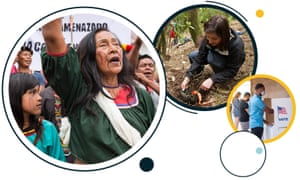
- (L) A Kofan woman from the community of Sinangoe celebrates her people’s historic legal victory against gold mining, Ecuadorian Amazon. Photo Jeronimo Zuniga / Amazon Frontlines
We must also recognize that Indigenous peoples are more than just victims in the destruction of their territories. Across the globe, Indigenous communities are quite literally our last line of defense to save the biosphere upon which we all depend. Their land stewardship, moral principles around leadership and relationship with the surrounding ecosystems is what we need to learn from and act upon. Supporting Indigenous-led organizations is especially important, as they could help drive rapid conservation of both land and sea.
Winters adds that you can volunteer or donate to initiatives working on the frontlines – like Amazon Frontlines and the Ceibo Alliance – or contribute to international environmental organizations, including the Rainforest Alliance, Rainforest Action Network and many more. Support calls to action, like the Global Deal for Nature, which calls upon world leaders to establish ambitious goals that both protect nature and restore Indigenous lands for the upcoming UN Convention of Biological Diversity. And, be sure to vote for leaders who advocate for renewable energy and preserving natural land.
“With the power of collective action fueled by optimism, we can do this,” Winters says. “It’s vital that we know it’s achievable and we are motivated to work together to create a future we want.”
Michelle Latimer’s contentious claim of Indigenous ancestry has understandably angered our community

Drew Hayden Taylor is an Anishnawbe playwright and humorist.
I’m not sure what exactly it is about the tail end of December, but it’s definitely not a good season for those claiming Indigenous ancestry but are unable to back it up. It was on Dec. 23, 2016, when it was revealed Joseph Boyden, Indigenous darling of the Canadian literary scene, had difficulty showing the secret Indigenous handshake.
Though there’d been rumours for a while, yesterday actress, producer, director and writer Michelle Latimer was accused of something similar. Coming off an amazingly successful year as producer and director of The Inconvenient Indian, a documentary adapted from Thomas King’s book, and creator of the CBC mini-series Trickster, based on Eden Robinson’s planned trilogy, her efforts were the culmination of several decades of hard work in the arts field.
Claiming a lineage originating in the Algonquin community of Kitigan Zibi, Que., Latimer was called to task to prove it. It was the community of Kitigan Zibi itself that questioned her connection, forcing Latimer to issue a mea culpa. “I sincerely apologize for naming the community of Kitigan Zibi publicly before I had done all of the necessary work to understand the connection.” Essentially it was family lore, not necessarily family fact.
‘I made a mistake’: Canadian filmmaker Michelle Latimer addresses Indigenous ancestry questions
Sometimes called race-shifting or being a pretendian, claiming Indigenous ancestry without evidence to prove it is a contentious issue in our community. Many are angered by her claims. Indigenous Twitter is incensed by the news, and understandably. The days of Grey Owl picking up the feather and batting his blue eyes at the Canadian public are long gone. We bat our own eyes.
Part of this anger comes from decades of struggle to no longer be considered second-class citizens. It had taken a long time to overcome the many colonial roadblocks set up by Canada and regain control of our own destiny. Once, not that long ago, we were not considered citizens; now we are a powerful force in governments, business, arts and education.
So after all that struggle, for some, it’s now fashionable to be Indigenous. Looking back, I don’t remember there being a line up of non-Indigenous people waiting to enroll in residential schools, singing The Huron Christmas Carol. It’s in. It’s vogue.
Some time ago, I met an older woman who ran an art shop. She told me she was Indigenous, even showed me her status card. Her business card had her spirit name on it … that alone should have been a warning. After some prodding, she confessed she was white and had married into the Nation before 1986, when non-Indigenous women were granted status upon marriage. Ironically, she had divorced the man but kept the card. I guess that’s what you get the woman who has everything.
Everybody talks about white privilege. But there’s also a lesser-known version called red privilege. Funding organizations, arts groups, award establishments, etc. have specific allotments geared for the development of Indigenous talent and enterprise. It’s felt those claiming an unjustified melanin surplus take those resources away from legitimate practitioners of their craft. In the big musical-chairs game of funding, there are precious few chairs available already.
Supposedly there are three stipulations to being accepted into the gracious and open arms of the Indigenous community. First is self-identifying – I eat bannock therefore I am. Second is being identified by the community – I’ve seen him/her eat bannock, therefore he/she is. Third is being able to trace your roots back to a specific area or people – my aunt, back in so-and-so, makes the best bannock. There is also a fourth possibility, being adopted by a person into their nation – I will give him/her my bannock recipe. Michelle Latimer’s bannock status right now is not very encouraging.
This issue is difficult. Identity is difficult. Saying somebody isn’t who they claim to be can be difficult. Conversely, I’ve seen non-Indigenous people partner up with somebody from our side of the path, and suddenly, they’re sweating glass beads. I am frequently worried about the AAA – the Aboriginal Ancestry Assessors, those who find the authority to say who is Indigenous and who isn’t.
I’ve worked with Michelle. She was in a play of mine in Thunder Bay. I found her to be an intelligent, talented and beautiful person. She said she was Indigenous, and I believed her. She still might be Indigenous. Latimer hired a genealogist to poke through the back drawers of Canadian history and has found some evidence of ancestry dating back to the 1700s. I wish her the best of luck. I do not support the vitriol being spoken about her, but I also acknowledge too many unauthorized people have tried to take our voice. Few things are more important to an individual and a people than their identity.
I myself have dealt with similar issues. Just after the Boyden affair, I received several emailed comments questioning my heritage. For the record, I have it on good authority I am half-white, but I literally cannot prove it. Seriously. There is no documentation verifying it. My mother never put my father’s name on the birth certificate. Short of a DNA test, people just have to take my word for it.
Kyrie plans to burn sage before every game, honors Native American heritage

Brooklyn Nets star Kyrie Irving was burning sage on the court before Friday’s preseason affair against the Boston Celtics.
Irving’s actions may have had something to do with his first visit to TD Garden since signing with Brooklyn in free agency last year, but the All-Star guard says he was honoring his Native American heritage and plans on carrying out the same ritual before every game this season.
“It just comes from a lot of native tribes,” Irving said following the Nets’ 113-89 win, according to ESPN’s Tim Bontemps. “Being able to sage, just cleanse the energy, make sure that we’re all balanced. When we come into this job, we come into this place, it’s not anything that I don’t do at home that I did today. I saged last game, and I plan to sage almost every game if the opposing team will allow me to.
“But, literally, it’s more or less for us to stay connected and for us to feel great about going to work and feeling safe and provided for from our ancestors. I’m not going to bring too much of the spirituality into basketball, but yeah, it’s part of my native culture where I’m from.”
Irving’s late mother was a member of the Standing Rock Sioux tribe. In 2018, he and his older sister visited the tribe and took part in a naming ceremony.
The former No. 1 overall pick has also incorporated the Standing Rock logo onto previous versions of his signature shoe.
Dr Hannah McGlade to research Sámi Parliament model

Nyungar woman Dr Hannah McGlade has been awarded the prestigious Churchill Fellowship to research the Indigenous Sámi Parliament model.
The Churchill Fellowship is awarded to the changemakers of society, providing opportunities to gain and exchange knowledge with global leaders.
For Dr McGlade, this opportunity will mean meeting with the Sámi Parliaments of Norway, Sweden and Finland later next year.
The Sámi people are Indigenous Finno-Ugric peoples from the regions of Norway, Sweden and Finland.
Dr McGlade has previously called for Indigenous representation in political affairs, and this pivotal research is expected to do just that.
With regards to Australia adopting a similar mechanism, Dr McGlade said Australia is “looking at a model already” — the much-awaited Voice to Parliament.
Dr McGlade took to LinkedIn to celebrate the announcement of the research fellowship.
“Indigenous representation and political voice is a key human rights issue, as the Productivity Commission report shows, shared decision making is essential to overcoming inequality,” she wrote.
In the meantime, Dr McGlade continues to advocate for justice reform for Aboriginal peoples; recently coordinating a Human Rights Forum on Aboriginal imprisonment at Curtin Law School.
“We wanted to commemorate the significance of Human Rights Day and to focus on the particularly pressing issue of humans rights in our state [Western Australia], and that is the incarceration of Aboriginal people,” Dr McGlade said.
“There are practices happening in prisons that are abusive, inhumane, and breach our international human rights world standards — in particular solitary confinement.”
Dr McGlade said an immediate solution for Western Australia would be to re-establish the Aboriginal Justice Committee and begin work on an Aboriginal Justice Agreement.
She is also pushing for an end to mandatory detention laws, an increase in the age of criminal responsibility from ten to 14-years-old and the abolition of Justices of the Peace in sentencing prisoners for prison offences.
For community members looking to act in solidarity, Dr McGlade strongly encouraged engagement with Reconciliation Australia.
Dr McGlade is set to undertake her research of Sámi Parliaments in 2021, pending COVID-19 travel restrictions.
Native electors help seal Biden win

Aliyah Chavez
Indian Country Today
The Electoral College formally chose Joe Biden on Monday as the nation’s next president, giving him a solid electoral majority of 306 votes and confirming his victory in last month’s election.
At least eight Native people across three states cast electoral votes in favor of Biden.
In Arizona, three of the state’s 11 electors were Native: Gila River Indian Community Gov. Stephen Roe Lewis, Navajo Nation President Jonathan Nez and Tohono O’odham Nation Chairman Ned Norris Jr.
In Washington state, two of the state’s 12 electors were Native. Native American Caucus Chair Julie Johnson, Lummi Nation, and Native American Caucus member Patsy Whitefoot, Yakama Nation, cast votes.
In New Mexico, one of the state’s five electors is affiliated with Laguna and Acoma Pueblos. The name of the elector was being withheld due to security concerns, the state’s Democratic Party confirmed.
Shannon Holsey, president of the Stockbridge-Munsee Band of Mohicans Tribal Council, cast an electoral vote in Wisconsin.
The state-by-state voting took on added importance this year because of President Donald Trump’s refusal to concede he had lost.
Heightened security was in place in some states as electors met on the day established by federal law. Electors cast paper ballots in gatherings with masks, social distancing and other virus precautions the order of the day.
The results will be sent to Washington and tallied in a Jan. 6 joint session of Congress over which Vice President Mike Pence will preside.
The Electoral College was the product of compromise during the drafting of the Constitution between those who favored electing the president by popular vote and those who opposed giving the people the power to directly choose their leader.
(Related: 3 Arizona tribal leaders among electoral voters)
Each state gets a number of electors equal to its total number of seats in Congress: two senators plus however many members the state has in the House of Representatives. Washington, D.C., has three votes, under a constitutional amendment that was ratified in 1961. With the exception of Maine and Nebraska, states award all of their Electoral College votes to the winner of the popular vote in their state.
The bargain struck by the nation’s founders has produced five elections in which the president did not win the popular vote. Trump was the most recent example in 2016.
Also in the 2016 election, Faith Spotted Eagle, Yankton, made history when she received Electoral College votes for president. Robert Satiacum Jr., Puyallup, cast his vote for Spotted Eagle and a vote for Winona LaDuke to be vice president.
The Supreme Court later found states can require presidential electors to back their states’ popular vote winner in the Electoral College.
UN experts raise concern over charges against US indigenous leader and rights defender

Independent UN human rights experts expressed serious concern on Friday over the arrest and charges brought against an indigenous leader, for peacefully protesting a political rally held last July at Mount Rushmore National Memorial, located on treaty lands of the Great Sioux Nation.
Nicholas Tilsen, human rights defender of the Oglala-Lakȟóta Sioux Nation and president of the indigenous-led NDN Collective, is due in court on 18 December, charged with four felonies and three misdemeanours after he and others blocked a road leading to a fireworks celebration event, led by President Donald Trump, which was held on 4 July at the South Dakota site in the Black Hills region.
“Obviously we cannot pre-judge the outcome of the case against Nicholas Tilsen, but we are seriously concerned about his arrest and the charges brought against him in connection with the exercise of his rights as an indigenous person, particularly the right to assembly”, the five UN Special Rapporteurs said.
Respect due process
The independent experts called on the US “to ensure that Mr. Tilsen’s due process rights are respected during the criminal prosecution and recall the obligation to ensure equal protection of the law without discrimination”.
They also voiced alarm over “allegations of excessive use of force by law enforcement agents against indigenous defenders, and recent reports of surveillance and intimidation by local police officers following the arrests”.
The 38-year-old was one of 15 peaceful protesters arrested in connection with the political rally – organized without the consent of the indigenous peoples concerned – to celebrate US Independence Day.
Rushmore hosts colossal sculptures of former presidents carved into the side of the mountain.
“I’ve worked hard to make a better way for our people. These trumped-up charges aren’t just against me, they’re against our people…designed to derail our movements. But we stand on the right side of history and we know our ancestors stand with us”, Mr. Tilsen tweeted in August.
COVID factor
Mr. Trump’s rally in South Dakota, one of the states worst hit by the COVID-19 pandemic, was held without the consent of the Great Sioux Nation.
It attracted some 7,500 people who did not wear masks or practice social distancing, according to a news release from the UN human rights office (OHCHR).
“It is absolutely essential that the authorities do more to support and protect indigenous communities that have been disproportionately affected by the COVID-19 pandemic”, the experts stressed.
“We also call on authorities to initiate dialogue with the Great Sioux Nation for the resolution of treaty violations”.
The experts who raised their concerns were José Francisco Calí Tzay, Special Rapporteur on the rights of indigenous peoples; Mary Lawlor, Special Rapporteur on the situation of human rights defenders; Clément Nyaletsossi Voule, Special Rapporteur on the rights to freedom of peaceful assembly and of association; E. Tendayi Achiume, Special Rapporteur on contemporary forms of racism; and Karima Bennoune, Special Rapporteur in the field of cultural rights.
Special Rapporteurs and independent experts are appointed by the Geneva-based UN Human Rights Council to examine and report back on a specific human rights theme or a country situation. The positions are honorary and the experts are not UN staff, nor are they paid for their work.
UArctic appoints new Vice-Presidents

The UArctic Board has formally approved Diane Hirshberg (University of Alaska Anchorage) as Vice-President Academic and Kirsi Latola (University of Oulu) as Vice-President Networks. Additionally, current UArctic Vice-President Research Arja Rautio (University of Oulu) was named as chair of the new Academic Advisory Board.
In her new role as Vice-President Academic, Diane Hirshberg plans include “highlighting some of the exceptional academic programming being done across UArctic and identify best practices for offering academic opportunities, supporting the efforts of the Læra Institute to expand Circumpolar Studies programs and courses, and increasing the number of academic offerings across multiple modalities such as short in-person intensives and summer schools, online course exchanges, and joint degree programs across institutions.”
Kirsi Latola has served for many years already as Director of Thematic Networks, and will continue that work as Vice-President Networks. Kirsi explains, “The expanding number of UArctic Thematic Networks and UArctic Institutes increases also the possibilities for collaboration and cooperation between the networks and we have already seen during the past few years that more thematic networks are collaborating and conducting joint activities such as projects, publications or events. I see this as an important step forward also in conducting transdisciplinary projects and engaging further with other Arctic organizations and projects. Increasing networking and cooperation both among the Thematic Networks and with other organizations and projects is one of the main aims for me in coming years.”
